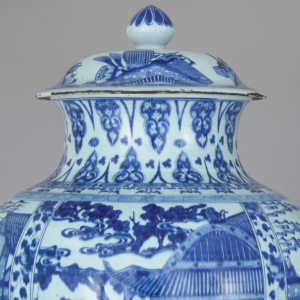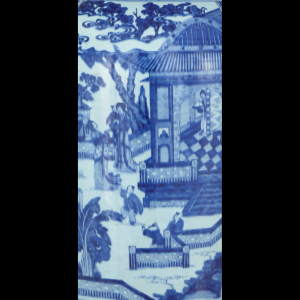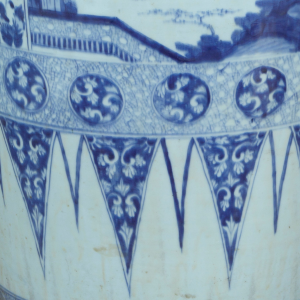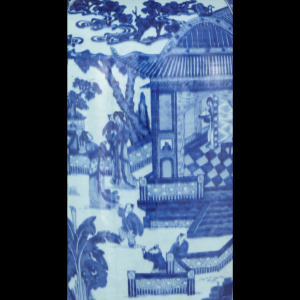Pot
Author: Unknown
Origin: Jingdezhen Kilns, China
Dating: c.1690 (Qing Dynasty, Kangxi period)
Material: Porcelain
Dimensions (cm): 106,5 x Ø 48
Inv. no.: PD0216
One of two “sentinel” pots, of extraordinary quality, whose decoration in cobalt blue narrates two distinct episodes involving men, women and children. It is believed that these episodes were inspired by the famous Chinese epic novel Sānguó Yǎnyì (Romance of the Three Kingdoms), written in the 14th century by Luo Guanzhong. It narrates the turbulent years of the end of the Han Dynasty (169-280 AD). The work, with over 800,000 words and almost 1,000 characters, is as valuable to China as Shakespeare for Anglo-Saxon literature.
It is believed that “sentinel” pots would decorate the interiors of palaces, flanking the access to chambers, and replacing the men who stood there as “sentinels or guards of honour”. In other words, the pots replaced the men but kept their name. Another version for the name originated in a rather unusual exchange of goods between Augustus the Strong – Elector of Saxony and King of Poland – and Wilhelm I of Prussia. Augustus exchanged a regiment of fit, well-trained men for 151 pieces of oriental porcelain, from the palaces of Charlottenburg and Oranienburg. Among the pieces, there were 48 large blue and white pots, which, due to their size, were compared to the soldiers, thus acquiring the name.
Kangxi Period
The Kangxi Emperor was one of the most important in Chinese history. His 61-year reign (1662-1722) was the longest in Chinese history and consolidated the power of the new Qing dynasty.
In terms of porcelain production, the Kangxi period was both innovative and a continuum of various techniques used previously. A large investment was made in the Jingdezhen manufacturing centre, reaching 3000 kilns.
The painting techniques, which developed during the Ming dynasty, reached a high level of technical refinement during the Kangxi period. In addition to the production of “blue and white” porcelain, the Famille-Verte (Green Family) was created – a palette composed of green, iron red, yellow, and purple, with blue enamel being added later (c. 1700).
This period became an era of great splendour that continued through the following reigns.








